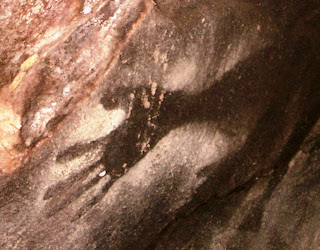One of the mala (specialists) in Aboriginal society was the painter of rock art. He painted with ochre - a type of clay which comes in different shades (pictured above). The artists would work only in a certain location, and his pictures would reflect the surrounding environment - its plants and animals, stories and events. The only plants and animals he painted were those which had a practical use. He also painted mythical and spiritual beings, and art which explained a fable or spirituality.
The milbi malin, or story-teller, is the person selected to translate the paintings into stories. He may also be, like myself, the story-keeper, who is responsible for passing the stories on - an inherited position which was handed down to me by my father. The milbi malin's responsibility is to explain the mythical and spiritual context of the art, and be able to detect minor details - shapes, size, and the different colours - in order to fully translate their meaning.
For example, if you look at the painting of the Jiliburu here, you'll see that this mythical figure is painted with stripes, whilst the emu underneath is in solid colour. This shows us the difference between real and imaginary, practical and spiritual. Often the story-teller has to tread a fine line between truth and myth. It is his responsibility not to mislead his audience, and to make sure that they understand the difference.
When it was the time to paint, the story-keeper and the artist would get together, and would nominate a site which was relevant to the story. They would sit and discuss what images would be painted in the caves, and whether the painting was to be about an event, food, animals, plants or the portrayal of something spiritual or mythical, such as the Rainbow Serpent.
Maintaining the paintings
The story-keeper and the artist were responsible for the maintenance of the paintings. When the artist died, then his replacement would create a new layer of paintings. You can see this clearly today at Wangaar-Wuri, and also see how the style of the painting varies between the layers. Style changes are particularly evident in the way hands and heads are painted. In the Food Cave (below) there are layers of figures, each painted in a different style.
Hand stencils are found in rock paintings throughout the world. In the Nugal caves you can see examples of the hand on its own, or with part of the arm as well. The hand stencils are mostly of thagu, the left hand, which is regarded as the signature of that person. The left hand was used because it is the peaceful hand, whereas nganhthirr, the right hand is generally the first used in anger. The stencils are often in white ochre, which was sprayed through a hollowed bone to create the spray effect.
Adding your 'signature' to a place can also signify belonging or acceptance. One of the hand stencil sites at Wangaar-Wuri was made as recently as the 1930s and has a wonderful family story of reconciliation attached to it.













No comments:
Post a Comment